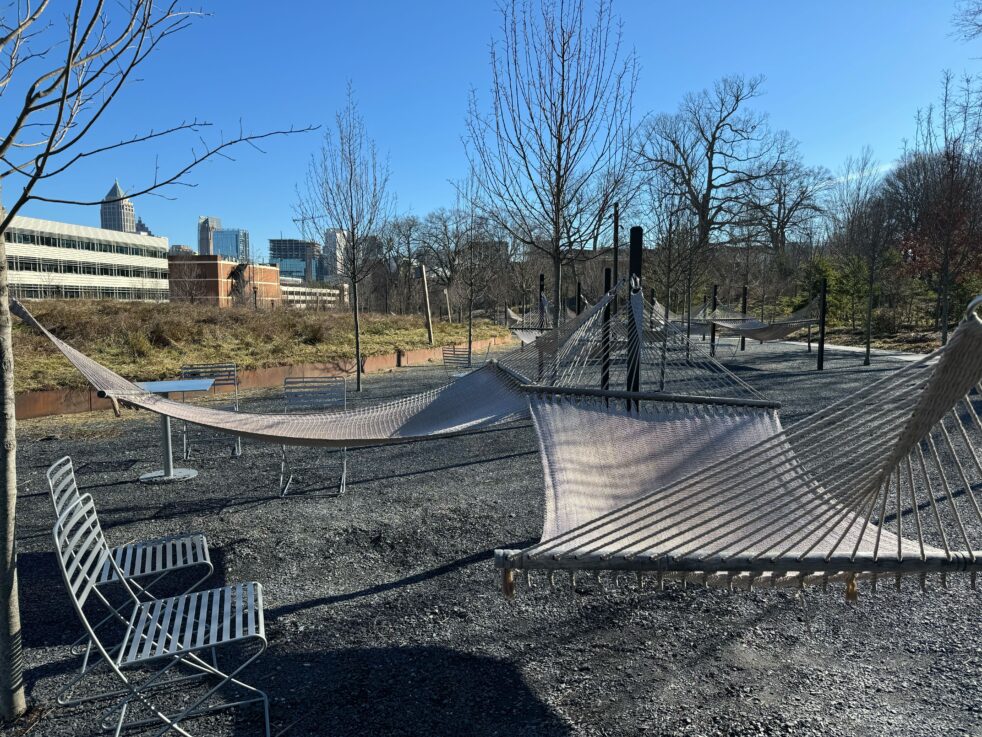The recent dreary weather has caused many on-campus residents to shelter inside and protect themselves from the cold and rain. Green areas across campus have been all but deserted, and the typical lounging and recreational activities have ceased.
Even though fewer people are utilizing the green areas on campus, these areas still play a vital role throughout the entirety of the year.
Planners consider the EcoCommons a large campus area specifically designed to facilitate the removal of stormwater from campus. The EcoCommons includes the traditionally considered area adjacent to the Kendeda Building, Tech Green, parts of Ferst Drive and the walkway between the Student Center and Campus Recreation Center.
The Institute designed the system to collect stormwater throughout campus and channel it to a city sewer or storm drain near the President’s house, where it can be taken off campus. The EcoCommons also attempts to give water a place to soak into the ground instead of being trapped on the surface.
The Technique spoke to Jason Gregory, the Institute’s landscape architect, about the design and purpose of the EcoCommons.
“[The area next to Kendeda] is only a portion of the EcoCommons. It is about eight of the larger 80 acres that are all part of a larger system that manages stormwater across campus,” Gregory said.
The EcoCommons area conforms to the natural environment, channels water and keeps it flowing downhill.
Designers considered the tendency of the existing water on campus and attempted to facilitate its flow by adding underground and above-ground natural channels for it.
“Identifying and planning for human landscapes, as well as ecological conditions and how those all work together to create a campus that’s unique to this place. This strategy is not an unusual process for planning and design. If you pay close attention to the place you’re working in, it will start to influence your design decisions,” Gregory said on the design philosophy behind the EcoCommons.
According to Gregory, the city sewage treatment facility handles a mixture of sewage and storm runoff water since sewage pipes are commonly used for storm runoff throughout the city. This constraint means that, when it rains, the treatment facility has to handle much more water than it is accustomed to.
This system was implemented and worked well when Atlanta was not as big, but due to an influx of growth, the water treatment plants can quickly become overloaded and over-burdened.
“When you have a big storm, all the water goes down to the pipes and the city system. That’s like a big bucket of water that they’re trying to treat. They can only hold so much water at that facility at one time,” Gregory said.
Gregory further explained that if the water treatment facility cannot hold all the water, it could overflow contaminated water into nearby waterways. These waterways eventually release into the Chattahoochee River, which leads to the Gulf of Mexico.
“So you start thinking about it globally. This process of managing stormwater more efficiently and allowing the land to clean the water, as opposed to letting the treatment facilities do it, has a much larger global impact,” Gregory said of the influence.
Tech is attempting to alleviate some of this pressure by regulating stormwater flow into the city sewer system. Underneath campus is an intricate array of pipes and stormwater drains that collect and transport water on campus and move it to a city sewer pipe.
Gregory said his team’s primary tools to manage the stormwater flow are cisterns and filtration cells. They use cisterns to store water to control the rate at which they can release it to the city system. One place where they used this strategy was Tech Green, where a 1.4 million-gallon cistern collects and manages the flow of water underground.
Filtration cells are another method of regulating stormwater that allows the water to soak into the ground before being released into the city system. This method is important in an urban environment, like Atlanta where much of the landscape is paved over.
Besides stormwater management, these areas can also serve as a place for research and exploration. Designers installed air quality, temperature, humidity, soil moisture and other sensors that anyone can view publicly online and could potentially aid in some research.
“I think there are opportunities for all kinds of different research to be advanced. Who knows if different researchers will use this information, but at least it’s available and can be leveraged over time,” Gregory said.
The area next to Kendeda also features an outdoor classroom where studio classes can learn about the EcoCommons or the natural environment. Gregory said that the whole area provides closer access to the natural environment for research and a way for students to explore how planners can integrate nature into the city landscape.
According to Gregory, there are also long-term plans to implement a water treatment system to clean stormwater for use in one of Tech’s own two water heating plants. While fewer people may enjoy the green space on campus this winter, these areas still serve a vital role in moving stormwater off campus while focusing on sustainability and considering Tech’s neighbors in an ever-expanding city.
